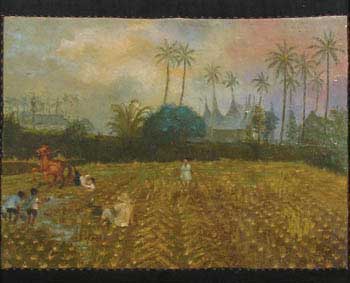 A family is upset that a man and a woman and a child trying desperately to escape the smoking volcano behind them. His anxiety is skillfully conveyed through the expressions on their faces and gestures. The outlines of a somber tone of the oils, extensively applied either with a spatula or brush, set the tragic tone of the painting.
A family is upset that a man and a woman and a child trying desperately to escape the smoking volcano behind them. His anxiety is skillfully conveyed through the expressions on their faces and gestures. The outlines of a somber tone of the oils, extensively applied either with a spatula or brush, set the tragic tone of the painting.This representation is disturbing Tarmizi Itji work, the youngest member of Sanggar pelukis Rakyat (People's Studio painter), who was considered one of the most talented painters in the country.
Tarmizi died on 28 November after a brief battle with liver cancer. Immediately after being diagnosed with malignant disease, only two months, his friends prepared a solo exhibition at a gallery in Kebon Jeruk, West Jakarta, from November 23.
Although he managed to inspect preparations for the exhibition the day before it began, was in serious need of medical attention at the opening day and could not attend the party. It was to be his first and last solo exhibition, and had never seen his works on display.
The artist seems to have had a rather unfortunate life. He was hearing impaired, making it difficult for him to communicate.
In 1953, Hendra Gunawan joined in the studio. Their presence was noted by art historian Claire Holt, who mentions him, and even includes pictures of two of his paintings in his book Art in Indonesia. Tarmizi Paintings can also be found in the art collection of President Sukarno.
In the 1960s, was in his prime, and produced his best work. One of his most monumental work is an interpretation of the family of a fisherman on the north coast of East Java, watching the horizon, as if anticipating a future promising. The painting is done in a style derived from the school of Russian social realism and resembles the kind of realism developed in China.
Reports not yet clear whether Tarmizi learned their techniques of painting in Russia or China, but suggesting that he had actually spent some time studying in Russia. Although he had recently begun to reveal their past experiences, tended to avoid questions related to travel to Russia or China.
The Rakyat pelukis LEKRA received substantial support from the Institute of Popular Culture. After the abortive coup on 30 September 1965, members were persecuted pelukis Rakyat.
Virtually all colleagues Tarmizi were captured and imprisoned. Miraculously, the artist was able to escape and return to their homeland in Lintau, West Sumatra, where he lived under the protection of her grandmother.
For over 30 years throughout the New Order era, which produces very few works, the quality decreased. Although never physically imprisoned, was not free to express their feelings and thoughts. His grandmother, he learned the art of embroidery, and produced his own compositions, which seem to have a cosmological meaning.
Towards the end of his life, seems to wear the suit only one of its own design, embellished with embroidery symbolic. These designs do not appear in the extensive exhibition gallery.
Tarmizi reappeared in the art scene in Indonesia after the fall of the New Order in 1998. By chance, a number of his works appeared in old art auctions in Indonesia and managed to see them. He also revisited his old works, many of which are still standing proudly in the homes of major art collectors.
Earlier this year, met with the painting of the fishing village of East Java. He spent a while watching the scene. It was like a father looking over his long lost son. He was inspired to paint again.
Although he worked hard to re-develop their skills in painting, his recent works lacked the strength evident in its output since the 1950s and 60s. In short, who had been out of practice for over thirty years.
Di Akhir Abad (End of the Century), completed at midnight, 31 December 2000, is a painting inspired by the monumental painting 1960 of the family in the fishing village in East Java. However, the figures in the aspect of recent work, such as primates, unlike the characters in the film Planet of the Apes, painted in pastel shades. To be honest, is very far from the previous piece.
Perhaps with practice, Tarmizi could be resurrected to become one of the greatest painters of Indonesia, but his health failed him. What I most regret not being able to conduct a proper interview with him. Communication with him was always very difficult.
Meirizal, his nephew, would spell out the questions asked him letter by letter, and then he answered his manner of expression, which was not easy to understand. His nephew, also would have to interpret what he was trying to say that let me understand what he meant.
Tarmizi enigmatic character and experiences were fascinating and important for us to know and understand. Unfortunately, his knowledge is gone forever and can only be studied through their artwork.
Tags: Arts, Painting


